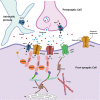Glycine Signaling in the Framework of Dopamine-Glutamate Interaction and Postsynaptic Density. Implications for Treatment-Resistant Schizophrenia
- PMID: 32477178
- PMCID: PMC7240307
- DOI: 10.3389/fpsyt.2020.00369
Glycine Signaling in the Framework of Dopamine-Glutamate Interaction and Postsynaptic Density. Implications for Treatment-Resistant Schizophrenia
Abstract
Treatment-resistant schizophrenia (TRS) or suboptimal response to antipsychotics affects almost 30% of schizophrenia (SCZ) patients, and it is a relevant clinical issue with significant impact on the functional outcome and on the global burden of disease. Among putative novel treatments, glycine-centered therapeutics (i.e. sarcosine, glycine itself, D-Serine, and bitopertin) have been proposed, based on a strong preclinical rationale with, however, mixed clinical results. Therefore, a better appraisal of glycine interaction with the other major players of SCZ pathophysiology and specifically in the framework of dopamine - glutamate interactions is warranted. New methodological approaches at cutting edge of technology and drug discovery have been applied to study the role of glycine in glutamate signaling, both at presynaptic and post-synaptic level and have been instrumental for unveiling the role of glycine in dopamine-glutamate interaction. Glycine is a non-essential amino acid that plays a critical role in both inhibitory and excitatory neurotransmission. In caudal areas of central nervous system (CNS), such as spinal cord and brainstem, glycine acts as a powerful inhibitory neurotransmitter through binding to its receptor, i.e. the Glycine Receptor (GlyR). However, glycine also works as a co-agonist of the N-Methyl-D-Aspartate receptor (NMDAR) in excitatory glutamatergic neurotransmission. Glycine concentration in the synaptic cleft is finely tuned by glycine transporters, i.e. GlyT1 and GlyT2, that regulate the neurotransmitter's reuptake, with the first considered a highly potential target for psychosis therapy. Reciprocal regulation of dopamine and glycine in forebrain, glycine modulation of glutamate, glycine signaling interaction with postsynaptic density proteins at glutamatergic synapse, and human genetics of glycinergic pathways in SCZ are tackled in order to highlight the exploitation of this neurotransmitters and related molecules in SCZ and TRS.
Keywords: Homer; N-methyl-d-aspartate; PSD-95; antipsychotics; disk-1; dopamine; glutamate; glycine transporter 1.
Copyright © 2020 de Bartolomeis, Manchia, Marmo, Vellucci, Iasevoli and Barone.
Figures

Similar articles
-
Glycine Transporters and Its Coupling with NMDA Receptors.Adv Neurobiol. 2017;16:55-83. doi: 10.1007/978-3-319-55769-4_4. Adv Neurobiol. 2017. PMID: 28828606 Review.
-
Glycine reuptake inhibition as a new therapeutic approach in schizophrenia: focus on the glycine transporter 1 (GlyT1).Curr Pharm Des. 2013;19(7):1311-20. doi: 10.2174/138161213804805766. Curr Pharm Des. 2013. PMID: 23194655 Review.
-
Interactions Involving Glycine and Other Amino Acid Neurotransmitters: Focus on Transporter-Mediated Regulation of Release and Glycine-Glutamate Crosstalk.Biomedicines. 2024 Jul 8;12(7):1518. doi: 10.3390/biomedicines12071518. Biomedicines. 2024. PMID: 39062091 Free PMC article. Review.
-
Glycine transporters: essential regulators of synaptic transmission.Biochem Soc Trans. 2006 Feb;34(Pt 1):55-8. doi: 10.1042/BST0340055. Biochem Soc Trans. 2006. PMID: 16417482 Review.
-
GlyT1 determines the glycinergic phenotype of amacrine cells in the mouse retina.Brain Struct Funct. 2018 Sep;223(7):3251-3266. doi: 10.1007/s00429-018-1684-3. Epub 2018 May 28. Brain Struct Funct. 2018. PMID: 29808289
Cited by
-
Gut Bacteria and Neurotransmitters.Microorganisms. 2022 Sep 14;10(9):1838. doi: 10.3390/microorganisms10091838. Microorganisms. 2022. PMID: 36144440 Free PMC article. Review.
-
1H-NMR-Based Metabolomics in Autism Spectrum Disorder and Pediatric Acute-Onset Neuropsychiatric Syndrome.J Clin Med. 2022 Nov 1;11(21):6493. doi: 10.3390/jcm11216493. J Clin Med. 2022. PMID: 36362721 Free PMC article.
-
Anger management: Mechanisms of glutamate receptor-mediated synaptic plasticity underlying animal aggression.Int J Biochem Cell Biol. 2022 Jan;142:106120. doi: 10.1016/j.biocel.2021.106120. Epub 2021 Nov 23. Int J Biochem Cell Biol. 2022. PMID: 34823006 Free PMC article. Review.
-
Novel Compounds in the Treatment of Schizophrenia-A Selective Review.Brain Sci. 2023 Aug 11;13(8):1193. doi: 10.3390/brainsci13081193. Brain Sci. 2023. PMID: 37626549 Free PMC article. Review.
-
Molecular investigation of ergot alkaloid ergotamine's modulatory effects on glycine receptors expressed in Xenopus oocytes.Comput Struct Biotechnol J. 2025 Mar 18;27:1148-1157. doi: 10.1016/j.csbj.2025.03.028. eCollection 2025. Comput Struct Biotechnol J. 2025. PMID: 40206345 Free PMC article.
References
Publication types
LinkOut - more resources
Full Text Sources

